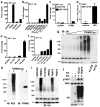TRIM5 is an innate immune sensor for the retrovirus capsid lattice
- PMID: 21512573
- PMCID: PMC3081621
- DOI: 10.1038/nature09976
TRIM5 is an innate immune sensor for the retrovirus capsid lattice
Abstract
TRIM5 is a RING domain-E3 ubiquitin ligase that restricts infection by human immunodeficiency virus (HIV)-1 and other retroviruses immediately following virus invasion of the target cell cytoplasm. Antiviral potency correlates with TRIM5 avidity for the retrovirion capsid lattice and several reports indicate that TRIM5 has a role in signal transduction, but the precise mechanism of restriction is unknown. Here we demonstrate that TRIM5 promotes innate immune signalling and that this activity is amplified by retroviral infection and interaction with the capsid lattice. Acting with the heterodimeric, ubiquitin-conjugating enzyme UBC13-UEV1A (also known as UBE2N-UBE2V1), TRIM5 catalyses the synthesis of unattached K63-linked ubiquitin chains that activate the TAK1 (also known as MAP3K7) kinase complex and stimulate AP-1 and NFκB signalling. Interaction with the HIV-1 capsid lattice greatly enhances the UBC13-UEV1A-dependent E3 activity of TRIM5 and challenge with retroviruses induces the transcription of AP-1 and NF-κB-dependent factors with a magnitude that tracks with TRIM5 avidity for the invading capsid. Finally, TAK1 and UBC13-UEV1A contribute to capsid-specific restriction by TRIM5. Thus, the retroviral restriction factor TRIM5 has two additional activities that are linked to restriction: it constitutively promotes innate immune signalling and it acts as a pattern recognition receptor specific for the retrovirus capsid lattice.
Figures




Comment in
-
Immunology: TRIM5 does double duty.Nature. 2011 Apr 21;472(7343):305-6. doi: 10.1038/472305a. Nature. 2011. PMID: 21512569 No abstract available.
-
Antiviral immunity: TRIM5 moonlights as a pattern recognition receptor.Nat Rev Microbiol. 2011 Jun;9(6):398. doi: 10.1038/nrmicro2582. Nat Rev Microbiol. 2011. PMID: 21572451 No abstract available.
-
Trim5 TAKes on pattern recognition.Cell Host Microbe. 2011 May 19;9(5):349-50. doi: 10.1016/j.chom.2011.05.003. Cell Host Microbe. 2011. PMID: 21575904 Free PMC article.
-
Antiviral immunity: TRIM5 moonlights as a pattern recognition receptor.Nat Rev Immunol. 2011 Jun;11(6):372-3. doi: 10.1038/nri3002. Nat Rev Immunol. 2011. PMID: 21610738 No abstract available.
References
-
- Sayah DM, Sokolskaja E, Berthoux L, Luban J. Cyclophilin A retrotransposition into TRIM5 explains owl monkey resistance to HIV-1. Nature. 2004;430:569–573. - PubMed
-
- Stremlau M, et al. The cytoplasmic body component TRIM5alpha restricts HIV-1 infection in Old World monkeys. Nature. 2004;427:848–853. - PubMed
Publication types
MeSH terms
Substances
Grants and funding
LinkOut - more resources
Full Text Sources
Other Literature Sources
Molecular Biology Databases
Research Materials
Miscellaneous

